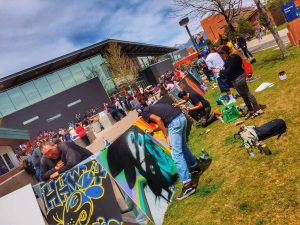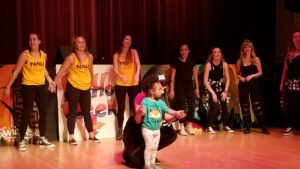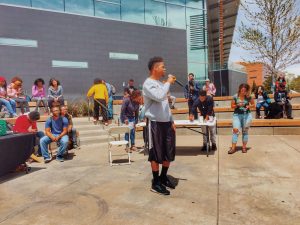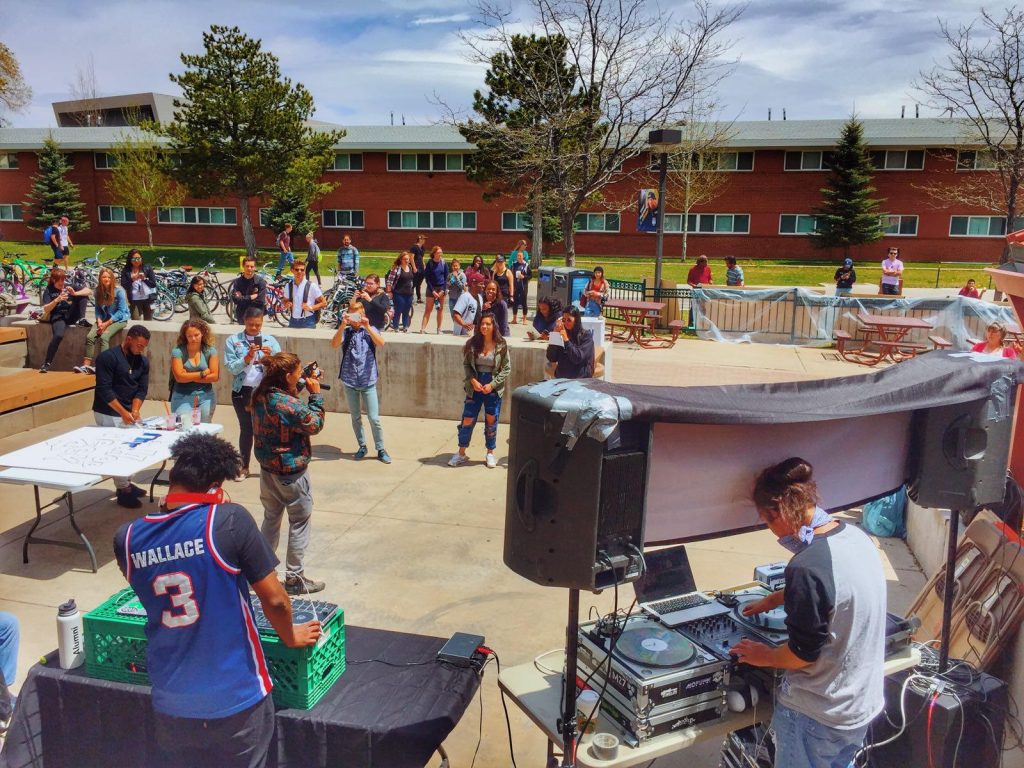By Heidi Toth
NAU Communications
Damian Purdy was in eighth grade when he made a life-altering choice.
The teenager had suffered a series of challenges and setbacks; he was hurting and alone. He couldn’t take it anymore. It was too hard. He was going to kill himself.
Switching on his music one day was an easy choice—an insignificant action he barely considered. The opening chords of Kid Cudi’s “Heart of a Lion” filled his ears, followed by the opening line: “Please save a kid that needs some help.”
At that moment, Purdy made another life-altering choice: He was the kid in pain who needed some help, but he wasn’t going to take his own life.
“Hip hop has literally saved my life, and I don’t mean that in a dramatic way,” Purdy said.
Next week, he’s sharing that love with the world—or anyone in the Flagstaff and Northern Arizona University communities interested in learning more about this musical genre or watching some top-notch artists dance, freestyle and produce street art. The junior fitness/wellness major is one of dozens of students in the Genius of Hip Hop class who will put on the fifth annual Hip Hop Appreciation Week from April 23-27, led by Ethnic Studies professor Frederick Gooding Jr.
Gooding, known to his students as Dr. G, researches African-American history and critical race theory in movies, media and sports. He and fellow ethnic studies professor T. Mark Montoya started Hip Hop Appreciation Week five years ago. The project serves a few purposes: offering leadership, organizational and public speaking opportunities to students; providing education about hip hop music—starting with the lesson that hip hop is not rap—and introducing different kinds of art and culture to NAU and Flagstaff.
The week is the culmination of almost a semester of work for his Genius of Hip Hop students, who have spent countless hours studying history, inviting artists, comparing different styles of music and in some cases, practicing their own talents to share.
“It’s a great way to share something very sacred to us,” said Destiney Waddy, a sophomore studying criminology and criminal justice.

The need for appreciation
Hip hop began in communities like the Bronx decades ago—communities that to a visitor looked like a bombed-out Beirut. Early hip hop artists put their fears, hopes, worries and loves into verse, sharing their stories with a world that wasn’t entirely ready to hear them yet. Even today, despite Kendrick Lamar winning a Pulitzer Prize—the first musician who’s not classical or jazz to do so—hip hop is a misunderstood, misrepresented genre.
The dozens of hip hop denizens in Gooding’s class are out to change that.
“Hip hop is a very powerful, poignant and poetic impulse that speaks to people’s desire for dignity, humanity and respect,” Gooding said.
Purdy and Waddell aren’t the only listeners with an appreciation that runs deeper than hip hop being good music. It is, they all say, but there’s so much more to it than that. For Lissette Flores, it was finding a community. The third-year criminal justice student isn’t even in the Genius of Hip Hop class. She took it last year, loving both the class and Hip Hop Appreciation Week enough that she continues coming to the class and is participating in the week’s activities. She’ll be MCing every day.
Considering how, prior to Hip Hop Week, she had no interest in being involved with any school-related activities, that’s a big deal.
“It’s like home,” she said. “It just goes. It flows.”
For Ian Thompson, hip hop is just a part of who he is. He doesn’t really separate himself from the music. Thompson, a third-year exercise science student, has been break-dancing since middle school and has loved hip hop—and felt it was underrepresented and overlooked—for as long as he can remember.
“The way we analyze songs in this class is the same way I did it in my head,” he said. “It is the fuel, it is the soul for my life. Everything I do is because of hip hop.”
Next week, that’ll be true of all the students. The week’s events are about more than introducing people to the facets of hip hop music. Gooding and his students want to educate people about the messages, the stories, the history behind this genre. They discuss the differences between rap and hip hop; rap is a genre regularly, and sometimes fairly, derided for its materialism, misogyny and mayhem, Gooding notes.
“Hip hop is something that you feel, rap is just something that you do,” said Aashli Morgan, a senior communications studies student and a third-time volunteer for Hip Hop Appreciation Week.
As a sophomore, she attended the hip hop class because it was fun and her friends were enrolled in it, as a junior she enrolled

and now she’s back for round three as Gooding’s teaching assistant.
To be clear, they have nothing against rap, Gooding said. But Hip Hop Appreciation Week is all about hip hop. They talk about how artists write songs that celebrate the humanity of everyone, including loved ones behind bars or those facing an early death; they analyze the symbolism behind words in much the same way English students analyze Emily Dickinson’s poetry; they glean life lessons from the likes of Kendrick Lamar and Nas and debate where Tupac belongs in the conversation. (It’s controversial.) Hip hop is not merely a form of entertainment, either for the artists or for their engaged audience. It is a way, Gooding said, for people whose voices have historically been silenced to stand up and say, “This is me. This is who I am.”
The five elements of hip hop
Hip hop is comprised of five elements, all of which will be present on at least one day of Hip Hop Appreciation Week. Taken together, Gooding said, they offer hope and encouragement as well tell the stories of the artists and the origins of their communities. Each of them also showcases a kind of intelligence that isn’t always noted in traditional circles.
DJing: Some songs have 10-20 seconds of really great dance music—music that was more animating, more instrumentation and really got people out on the dance floor. But traditionally, by the time the partygoers started dancing, that stretch of song was over. However, Gooding said hip hop DJs decided to put two record players together, playing 20 seconds on one, then switching over to the other while rewinding the first one. That 20 seconds of great dance music was suddenly two and a half minutes long. It seems simple, he said, but no one else had done it and it changed the face of party music.

MCing: MC Supernatural once freestyled for nine hours and 15 minutes. All he had was a beat, and the world record-holder freestyle MC put together word combinations that rhymed, made sense and stayed on beat.
It’s a different way of thinking about genius, Gooding said. The ability to freestyle isn’t a typical measure of intellect, but a performer who can think up word combinations that make sense and rhyme and stick with a beat with no rehearsing beforehand—and do it for nine hours—is undeniably smart.
Break dancing: Remember that part of a song that an innovative DJ figured out how to keep looping? That break period is when people were most stimulated by the sound and pulled out all their funky dance moves. Thus break dancing, or bboying and bgirling, were born.
“This is not something that I just want to sit in my chair and tap my toe to,” Gooding said. “I want to get up and start spinning on my head. That’s how energized the music makes them feel, and I think we should recognize the profound power of that.”
Street art: On Monday, dozens of artists will create beautiful images that describe themselves and their lives using only spray paint on canvas. Street or graffiti art is the outlet many inner-city artists found for their art. Gooding acknowledged graffiti can be destructive while asking another question:
“What do you do when you are trapped in a concrete jungle and you don’t have canvas to work with? What do you with when there’s art inside of you?” Gooding asked. “People who reside in inner cities claim the place as their own.”
Knowledge of self: The world can be confusing and difficult to navigate. This is especially true for people of color, Gooding said, who often find themselves in environments that in theory are just and fair but in practice often fall short of that. Pain, disappointment, grief and frustration can follow that cognitive dissonance. Hip hop music is full of positive and affirming messages—You can do it. Somebody loves you. I remember you. The music often derided and stigmatized is actually providing hope to generations of people.
“I think that’s one of the reasons it resonates with so many people all around the world,” he said. “This is the only way we can express ourselves fully and truly.”
It is an event worth attending, students said—good enough that last year, after a nasty bout of stomach illness, Waddy went straight from the hospital just to watch a performance; good enough that Thompson, who has injured himself from the stress of break dancing, is willing to put his body through more to share his love of the art; good enough that Flores, despite her devotion to Hip Hop Appreciation Week, doesn’t have the words to describe how good it is.
“There’s no way to contextualize that kind of energy,” she said.
For details about all the events, visit the NAU Hip Hop Facebook page or follow the group on Twitter @NAUHipHop.



